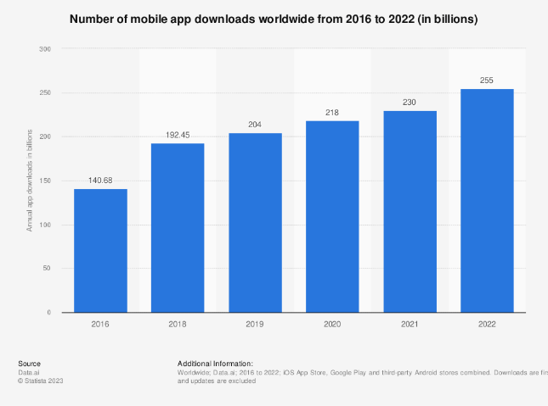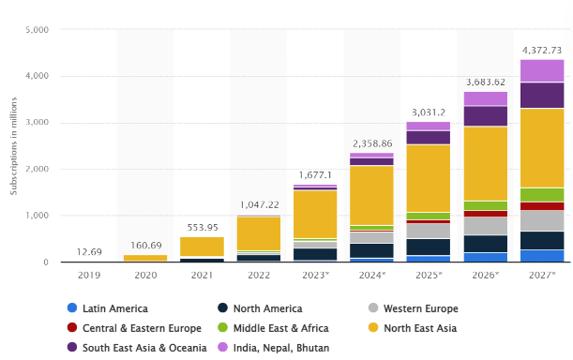For a number of years now, digital transformation has been touted as one of the world’s most powerful trends. Recently, Artificial Intelligence (AI) has taken center stage and promises to impact everything we do. So how will AI, in conjunction with Machine Learning (ML), impact digital transformation?
In plain sight
Digital transformation is happening everywhere you look. As individuals, we now consume entertainment, order taxis, plan our vacations, drive, read books (at least I hope some of us still do), order food, punch in and out of work, remotely meet with colleagues, customers, and teachers, consult with doctors – and the list goes on and on – in ways that were unthinkable just a few years ago. As this graph from Statista shows, the number of mobile apps downloaded annually rose from 140 Billion in 2016 to 250 Billion in 2022 so it's no surprise that these digitally transformed experiences touch nearly every aspect of our lives.

Under the radar transformation
What many of us don’t realize is that digital transformation is also radically altering the industries and social services that operate in the background, making it possible to live our lives in the modern world. While many of us still turn on faucets to get our water and flip switches to turn lights and other appliances on and off, behind the scenes, the underlying industries and utilities that make this possible are also being digitally transformed. Millions upon millions of Industrial IoT devices sense, monitor, and control nearly every aspect of the production, storage, and transport of water, power, oil, gas, food, and other key commodities so that they reach us on time and at acceptable quality. According to Analysys Mason, “the number of private LTE/5G network deployments worldwide … will grow at a CAGR of 65% between 2021 and 2027… spending on these networks will rise to USD7.7 billion during the same period”.
Municipal services such as lighting, security surveillance, WiFi, smart parking, and more are other aspects of Digital Transformation that we take for granted. We have become so used to this “magical world” that we become frustrated when overloaded or remote locations slow down or prevent our “everything at our fingertips – and always available” access to these services.
What all of these transformations have in common – the underlying communications networks that make all of this possible – are themselves another striking example of digital transformation. The move from 4G to 5G is often described as a revolution rather than an evolution because of the combination of massive bandwidth, exponentially greater IoT connectivity, and ultra-reliable low latency that together will enable even greater levels of digital transformation. Another Statista report from 2022 projects 4.4B 5G subscribers by 2027, accounting for 83% of mobile traffic (ABI Research). Autonomous vehicles, immersive experiences, and a host of robotic e-health and industrial applications are coming faster than we think.

And it’s the public and private communications networks that are making this possible. These networks are the information highways, and they need to continuously evolve to support the ever-growing demand for ubiquitous, limitless, and nearly instantaneous connectivity.
AI is truly transformative
AI is much more than just a powerful tool to enhance productivity and efficiency. It has the potential to transform industries, revolutionize healthcare, improve education, tackle climate change, and address societal issues. AI will help organizations make informed decisions, drive innovation, and enhance customer experiences. Overall, AI has the power to revolutionize society and drive positive change.
Full disclosure – a popular, generative AI tool wrote the last paragraph – and it’s fairly accurate. However, I would like to talk about how AI and ML can impact the information highway itself to transform the digital transformation that is already underway.
The public network information highway is the core business of communications service providers, and monetizing it is a key challenge. On the other hand, for multiple industries and enterprises that simply need them to work efficiently and cost-effectively, public and private networks are key enablers that let them get on with their actual business and deliver services to their end customers.
Looking ahead
Looking ahead to 2024, we expect Artificial Intelligence to play a growing role in transforming how the information highways of the world are designed, deployed, and managed in order to deliver sustained, maximal return on investment (ROI) and to keep up with ever-growing capacity demand. One way that AI can improve ROI is by enhancing energy efficiency – and this will also contribute to meeting sustainability regulations and carbon footprint targets. For example, Ceragon has found that by utilizing AI and ML to analyze link utilization in multi-carrier scenarios, it is possible to detect timeframes where carriers can safely be disabled, thereby reducing energy consumption by 15-20% without impacting traffic or quality of experience.
Designing the right network that fits your traffic is critical to avoid wasting money on over-purchasing and over-provisioning unneeded capacity. Analyzing link capacity, throughput, and utilization trends is critical to understanding how to maintain and expand your network while limiting your spending to what you need, when, and where you need it. Advanced tools powered by AI and ML can gather and analyze the relevant network topology, usage traffic, and error data more quickly, thoroughly, and accurately than human beings can and, if properly designed and implemented, can project accurate trends that will maximize the bang-for-the-buck that network owners receive from their spending.
At Ceragon, we have integrated AI and ML into our network intelligence and management software solutions to optimize the operations and performance of wireless transport in both public and private networks. These AI-powered tools save time and money by more effective monitoring of network health to better predict and prevent major issues and to quickly identify and resolve problems that do occur. They also drive advanced deep analysis of network trends that enable optimized network expansion.
Moving forward, AI and ML will increasingly transform other aspects of our data highways, not just their operations. Utilizing external data, such as evolving or recurring weather patterns, could enable routing decisions that will avoid signal interference caused by environmental factors. Understanding evolving traffic patterns could prevent reaching congestion thresholds by implementing scenario-specific resource allocation. Analysis of network configuration data could detect sub-optimal deployments that can be upgraded to improve traffic. The field of threat detection and mitigation is another area where AI/ML can enhance the information highway, safeguarding our connected world and further transforming our digital lives. So, keep an eye on AI in communication networks as we continue to digitally transform in 2024!
Optimize your network's performance


